Maison Margiela, Iris Van Herpen, Chanel and Balenciaga at Paris haute couture week
After 18 months of pandemic-induced digital innovation, does the traditional catwalk seem almost passe?
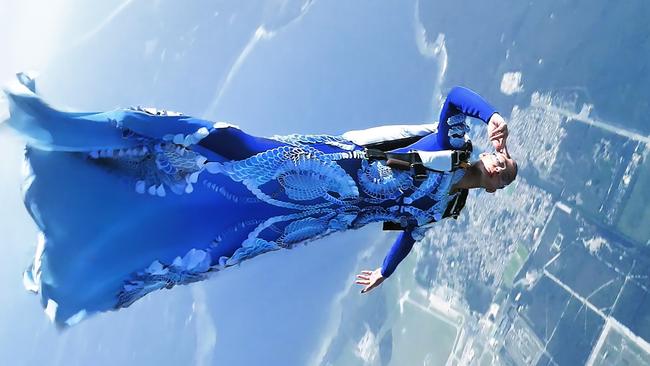
Fashion has come to a crossroads. Which way to go from here – the route that takes us back to what was always known, or the one that leads to the future?
It’s an interesting question when you consider the recent Paris haute couture week. With restrictions easing in time, nine of the 33 houses showing their autumn-winter 2021-22 collections opted for live catwalk events. It was almost like old times.
But what of all the lessons learnt in the digital realm over the past 18 months since Covid-19 forced the fashion world online?
If the resulting executions are anything to go by, many designers have finally realised they can play with the parameters, realising the freedom and control over presentations when they are created for digital.
In the past year, this journalist has spoken to a number of designers who have relished the level of control that film and video offer them, with no chance of catwalk mishaps forever committed to photographs and video footage.
Equally, there remain plenty of designers who say that nothing can ever take the place of the live catwalk experience. And in some cases – at its best – they’d be right.
But there were times in the past week when the live catwalk seemed almost out of step – even a step backwards – when we have spent the pandemic pushing forward. And especially as the level of innovation in the digital space continues to grow.
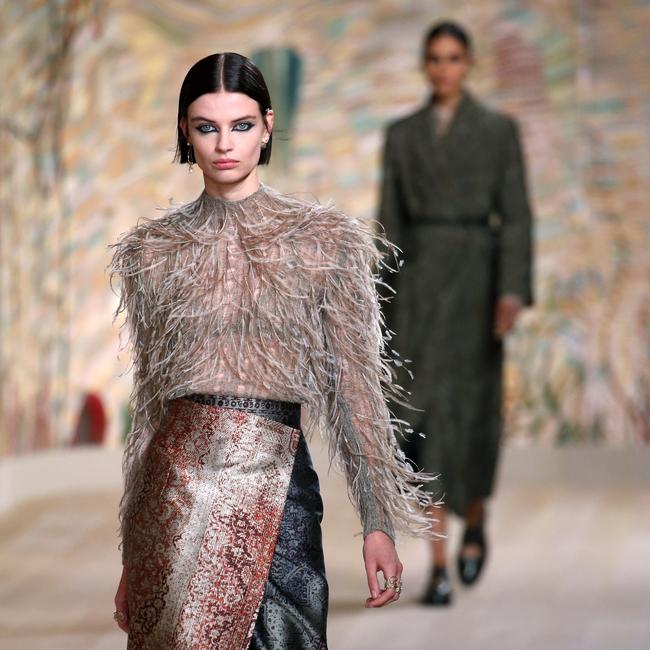
As has been proven time and again in the past 18 months, watching a custom-created video of a collection can offer much more detail for the viewer than even a live-stream of a live catwalk.
It’s a bit like couture, in that sense.
Christian Dior, Chanel, Armani Prive, Jean Paul Gaultier and Balenciaga were among those opting for live events, and for some there was an absolute logic in doing so.
The opportunity for Demna Gvasalia to present Balenciaga’s first haute couture show in 53 years – in the restored couture salons of the house itself, where founder Cristobal Balenciaga presented his collections in a similarly hushed silence – was something that couldn’t be replicated in the digital world.
For those 70 people in attendance, it will forever be a landmark occasion, and one that put paid to any suggestion that a designer best known for postmodern streetwear couldn’t tackle couture.
Chanel showed Virginie Viard’s latest collection at the Palais Galliera, the Paris fashion museum whose recent renovations were supported by the fashion house and where an exhibition celebrating the founder, Gabrielle Chanel, is currently on show. Again, there was a synergy in the choice of location in which to show Viard’s take on impressionist artists, adding blurred florals and delicate pastels to the tweeds and dresses that skewed more towards daywear than extravagant eveningwear.
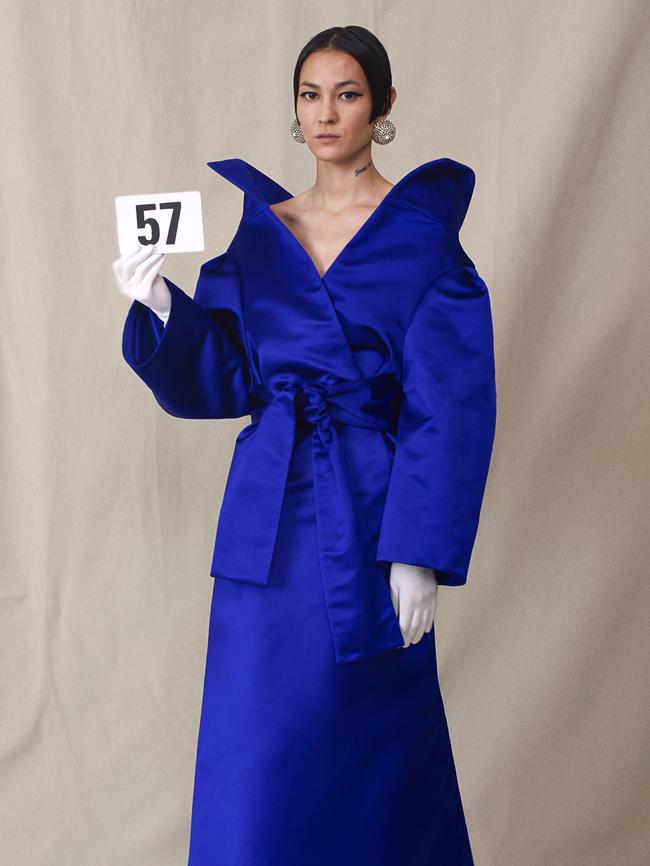
Dior’s subtly hued collection read beautifully against the embroidered walls of Chambre de Soie, an artwork by Eva Jospin created by artisans in India, the whole event an homage to handcraft.
And, while Gaultier’s first “takeover” by Sacai’s Chitose Abe – part of his new concept of guest designers interpreting his body of work – was an audience-worthy event, you can’t help but wonder if such an unusual concept might have been equally well served by something as innovative in the digital space.
And there were plenty that showed the range of possibilities in that realm during the week.
At its simplest, studio setups that focused on the garments and details therein were taken up by designers including Alexis Mabille and Alexandre Vauthier.
Schiaparelli was among the most effective here. Daniel Roseberry’s Matador Couture collection was seen in all its glory in just four minutes.
From the embroidered details of a matador jacket to the fabric floral appliques running down the sleeves of a dress, a black gown whose sides exploded in gold ruffles, or a necklace whose enormous pendant resembled the bronchial tree of the lungs, and sat over same, the camera took in everything.
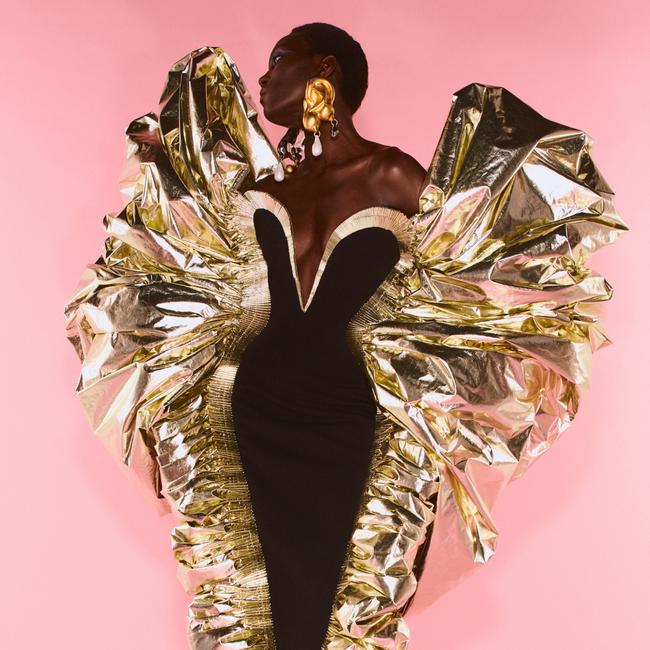
Similarly, Viktor & Rolf’s regal collection, The New Royals, saw slogan-sashed models stare down the lens as the camera panned up and down the looks that included raffia “fur” coats and patchwork brocade dresses embellished with oversized paste jewels.
Alexandre Vauthier’s 80s-inspired collection mixed grainy studio footage for atmosphere, aided by Visage’s Fade to Grey, with clearer video footage of looks that included oversized pinstripe suiting, metallic mesh minidresses and fringed leather jackets.
The traditional catwalk still holds a certain allure when planning digital presentations. Houses including Azzaro, Elie Saab, Rahul Mishra and Christophe Josse played with variations on the theme, whether on a runway proper or set in locations in which models wandered or strutted for the camera.
Mishra’s collection, the Shape of Air, was inspired by a pre-pandemic trip to Greece, and mixed his perpetual love of nature with the deep blues of its sky and sea. The undulating waves of the ocean were obvious in a tiered trapeze dress in layers of ocean blue tulle and sequins. In another look puffs of cloudlike white organza on sleeves encased flowers and the buildings of Santorini, picked out in sequins and embroideries, and perfectly visible to viewers in a way that may have seemed less obvious in a fleeting view on a runway.
Fendi’s custom-built set mimicked the Rome headquarters of the house, its stark lines and archways populated by models, evocatively captured by film director Luca Guadagnino.
Giambattista Valli’s explosive tulle confections were seen in stark contrast to the concrete “catwalk” of the Espace Niemeyer in Paris, the stark grey the perfect foil to the pastel and sorbet hues of the ruffled minidresses and layered ballgowns taken in at length by the camera from a multitude of angles.
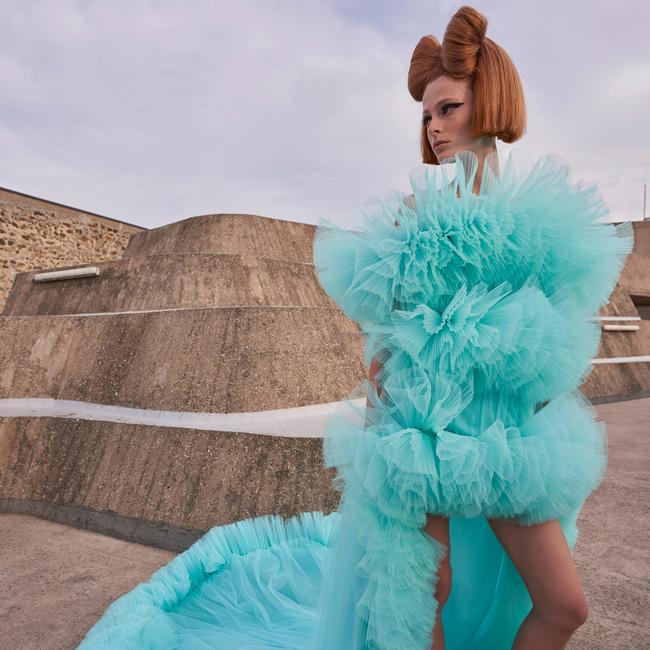
Some took the digital presentation to new heights – in one case, quite literally.
Maison Margiela took the most engaging approach with a narrative-style film, A Folk Horror Tale, directed by Olivier Dahan.
At over an hour, it was also the most expansive. But it started with a 20-minute explainer from creative director John Galliano, which was insightful from the conceptual to the technical. In summary, it was about “how we all felt through this pandemic, and being brought to our knees by the power of mother nature”, he explained.
Set in a fishing village, possibly in The Netherlands, this pandemic tale involves an oozing black pestilence that arrives via a phantom galleon in the 1800s that wipes out its inhabitants; fast-forward 100 years to a sect called the Holmcliff Hermits, who have taken over the abandoned relics, their jumpers darned and patched with original newspaper clippings of the death of King George V; jump to today, and a solitary traveller arrives at the same location, only to find a similar fate to the original inhabitants after a series of hallucinatory visions.
Galliano described the creation of a lavish upcycled coat, patchworked from “all of the emotion you could find from charity shops” – including “old bandanas, aprons, workwear, businessmen’s shirts”. Other key items included a sweater made up of knitted squares that mimicked Delft blue tiles, while a dress and crown made of pieces of broken mirror played a central role in the film. Margiela’s signature tabi shoes were turned into clogs, and shiny thigh-high waders added a touch of kink.
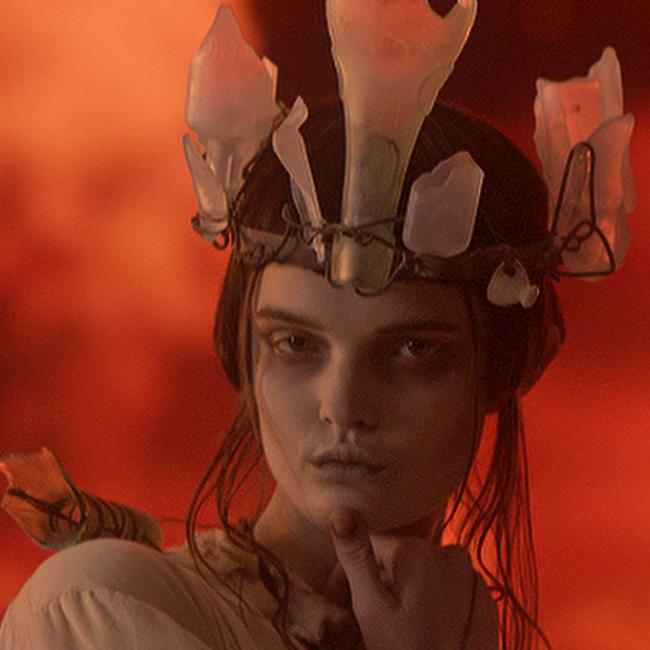
The film was ambitious, and delightfully gruesome to watch. Knowing the work that went into the collection before watching made it even more so.
Perhaps the most innovative film of the week came from one of the fashion world’s most experimental designers, Iris Van Herpen.
The Dutch designer has long melded art and science, and regularly collaborates with experts in both, and was an early exponent of 3D printing. Her Earthrise collection was presented in a film that expanded horizons, quite literally, including imagery of the Earth taken from Apollo 8.
The bulk of the collection was shot atop the Dolomite Mountains in Italy, which appeared as remote and desolate-looking as an uninhabited planet. As models jumped upwards, their diaphanous printed silks wafted into the skyscape, while the designer’s alien-like skeletal patterning seemed oddly in tune with the environment.
The final shots were of French female world champion skydiver Domitille Kiger. She appeared to float among the clouds, above the world, her dress fluttering at the base, obscuring her feet, arms outstretched like a benevolent spirit. It was a startling image, made even more so by the fact that it wasn’t mere CGI trickery.
As with this haute couture week, the catwalk will undoubtedly continue as the world opens up again, and will coexist with digital, where creatives can push boundaries, and customise their own visions to showcase their collections.
And this season, Van Herpen’s film was proof that in the new world of digital presentations, the sky is not even the limit.
